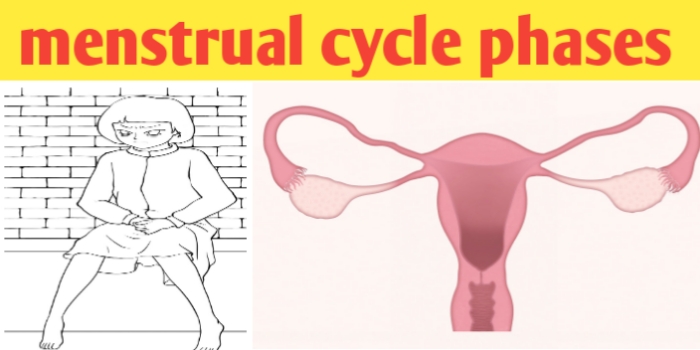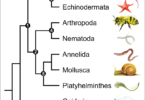Menstrual cycle phases: menstruation,ovulation and hormones
Reproductive period of human female is about 30 to 33 years which is extended from puberty 10 to 14 years to Menopause 45 to 55 years. During this reproductive period of ovaries and female reproductive system undergo a series of cyclic changes which are primary meant to prepare them for fertilization and pregnancy and these collectively known as menstrual cycle.
in this article we read about menstrual cycle phases, menstruation, ovulation and menstrual cycle hormones. Most peculier feature of this cycle is the periodic vaginal bleeding called as menstruation which last for about 4 days.

Menstrual cycle phases: menstruation,ovulation and hormones
Puberty period in female start from 10 to 14 years of age in which is hormone estrogen initiate the development of secondary sexual character and organ in female. So menstruation cycle start from puberty age and it last for Menopause period.
Menopause is the period when ovulution and menstrual cycle stop in human female. And Menopause period is between 45 to 55 years. Menopause is characterized by hot flushes sensation of Warmth spreading from the trunk to the face and number of psychic symptoms.
Table of Contents
Length of menstrual cycle in human female
The period and the length of menstrual cycle varies widely in women but on average it is completed in 28 days. In a female successive cycles vary in length by 1 to 2 days. it is absent during pregnancy may be suppressed during lactation and permanently stop at Menopause period.
◆ Follow me on YouTube
◆ VISIT ON OUR YOUTUBE CHANNEL BIOLOGY SIR FOR MORE VIDEO
And irregularity in menstrual cycle caused due to several reason and identifying common issues in female every woman’s menstrual cycle is different. Some women get their period at the same time each month and Others are more irregular. Some women bleed more heavily or for a longer number of days than others.
Your menstrual cycle can also change during certain times of your life. For example, it can stop during pregnancy and suppress during lactation period and permanently stop during Menopause period or get more irregular as you get close to menopause.
One way to find out if you’re having any issues with your menstrual cycle is to track your periods. Write down when they start and end. Also record any changes to the amount or number of days you bleed, and whether you have spotting between periods.
What are the reason for irregularity in menstrual cycle?
1) Birth control:- The birth control contraceptive pill may make your periods shorter and lighter. While on some pills, you won’t get a period at all. So taking contraceptive pills for birth control may make a irregularity in menstrual cycle.
2) Pregnancy:- Your mens periods should stop during pregnancy. Missed periods during month are one of the most obvious first signs that you are pregnant.
3) Polycystic ovary syndrome:- it is also known as PCOS. This hormonal imbalance of LH and FSH prevents an egg from developing normally in the ovaries. PCOS causes irregular menstrual cycles and missed periods.
4) Uterine fibroids:- These are noncancerous growths in your uterus can make your periods longer and heavier than usual and it can create irregularities in mens period.
5) Eating disorders. Anorexia, bulimia, and other eating disorders can disrupt your menstruation cycle and make your periods stop.
few signs of irregularities of menstrual cycle
1) You have skipped periods, or your periods have stopped entirely.
2) Your periods are irregular.
3) You bleed for more than seven days.
4)Your periods are less than 21 days or more than 35 days apart.
5)You bleed between periods heavier than spotting.
6) If you have these or other problems with your menstrual cycle or periods, talk to your gynecologist doctor.

Menstrual cycle phases: menstruation,ovulation and hormones
What are the four menstrual cycle phases ?
Menstrual cycle phases broadly categorised into four phases:
1) Follicular phase: follicular phase is also known as proliferative phase or post menstrual or preovulatory phase.
2) Ovulatory phase
3) Luteal or Progestational or pre- menstrual or secretory phase or post ovulatory phase
4) menstrual phase
Describe the follicular phase of menstrual cycle
follicular phase is also known as proliferative phase or post menstrual or preovulatory phase. This menstrual cycle phases follows the menstrual phase and last for about 10 to 12 days starting from 5th and end to 14th day of menstrual cycle.
Under the control of hypothalamus which release gonadotropin releasing hormone initiate and stimulate the anterior pituitary gland to Secrets follicle stimulating hormone (FSH). During follicular phase fsh concentration is high and it stimulate the change of primary follicle to the mature ovarian follicle known as Graafian follicle.
Follicular cells of developing follicles secrets estrogens hormone and oestrogen hormone are responsible for sexual Desire in female and attract towards opposite sex and it is stimulate the growth maintenance and normal functioning of secondary sex organ, and initiate the puberty in female and responsible for development of secondary sexual character like inlargement of breast and development of mammary gland.
During follicular phase the endometrium become thick about 2- 3 mm thick, more vascular and more glandular, the uterine glands become tortuous and cork- screw shaped. so it repair itself for implantation.
The epithelium of fallopian tubes become thick and densely ciliated to conduct the ovum or zygote
At the end time of follicular phase inhibit the secretion of follicular stimulating hormone (FSH) and stimulate the secretion of luteinizing hormone (LH) from the anterior pituitary glands. And glycogen and fat molecules accumulate in the endometrial cells.
What is ovulatory phase and ovulation ?
It involves the release of mature secondary oocyte from the Graafian follicles of ovary known as ovulution. it occurs Midway between two menstrual cycle on average 13 day of one set of menstrual cycle.
Ovulation is controlled by increased level of luteinizing hormone in blood, on 13 day of menstrual cycle luteinizing hormone concentration is high in blood that is known as LH search. High concentration of LH hormone in blood causes rupturing of Graafian follicles and release of secondary oocytes.
During ovulatory phase there is increasing turgidity and contraction of smooth muscles fibre around the graafian follicles, ovum is received by the fimbria of fallopian tube and ovum is viable for 2 days.
Luteinizing hormone LH also start the change of empty Graafian follicles into Corpus luteum and secretion of progesterone from Corpus luteum and there is no much changes in uterine endometrium during ovulatory phase.
Describe about luteal or secretory phase of menstruation cycle
It last for about 12 to 14 days and extend from 16th to 28 days of menstrual cycle. And it is characterized by following changes
Corpus luteum full of fluid material that is known as yellow pigment lutein that’s why it is also known as yellow body. During this phase Corpus luteum increase in size so it is known as luteal phase.
Corpus luteum secretes progesterone hormone which level in blood gradually increases and induces following changes:
Progesterone hormone decrease the secretion of fsh and LH gonadotropin from anterior pituitary so inhibit the maturation of follicle and ovulution.
Progesterone hormone initiate uterine endometrium further Proliferates about 5 mm thick and is ready for implantation uterine gland secretes to uterine milk for the foetus. And it also help in reduce the uterine movement.
Describe about menstrual phase
It last for about 3 to 5 days and extend from 1st to 4th day of menstrual cycle. When the ovum remain unfertilized then the Corpus luteum start degenerating. The level of progesterone in blood declines the uterine tissue fail to be maintained. Then the unfertilized ovum along with uterine epithelium about 5200 ml of blood and some mucus is discharged out through the vaginal orifice and it is known as menstrual flow or menstruation.
However if fertilization occurs then blastula undergoes implantation and chorionic Placenta is formed between the foetus and mother. Placenta secrets human chorionic gonadotropin HCG which maintain the Corpus luteum and the progesterone secretion continue and progesterone maintenance pregnancy and prevent ovulation during the gestation period.
If fertilization not take place after menstrual flow there is decrease in level of progesterone and oestrogen in blood stimulate the hypothalamus and anterior pituitary to release fsh and LH hormone to continue to start next follicular phase of menstrual cycle.
What are sign and symptoms of menstrual phase
During menstrual phase there is several sign and symptoms like cramp in body, tender breast, bloating, mood swings, irritability, headaches, tiredness, low back pain. During menstrual flow Little cramp or pain in lower abdominal cavity.
Female feelings mood swings they have sadness and tiredness and not desire to do any work.
What are menstrual cycle hormones ?
The length of menstrual cycle in female is 28 days average. And complete menstrual cycle is controlled by 4 hormones like, follicle stimulating hormone (FSH), luteinizing hormone (LH), oestrogen hormone and progesterone hormone.
1st day to 4th day of menstrual flow decrease the concentration of fsh and LH hormone in blood, which initiate the release of fsh and LH hormone from anterior pituitary gland which is initiated by gonadotropin releasing hormone from hypothalamus.
Follicular stimulating hormone fsh stimulate the development and formation of primary follicles into mature Graafian follicles. During 5th day to 13 days there concentration is increasing in blood.
◆you should also visits our website https://biologysir.com and other website for civil engineer calculation at https://www.civilsir.com
■ follow on YouTube
◆name of fathers in field of Biology
● all full forms of 11th and 12th Biology
Developing follicles release oestrogen hormone which initiate the puberty, development of secondary sexual organ in female reproductive system and development of secondary sexual character like enlargement of breast and mons pubis hair and also feeling of sexual Desire in female body. Level of oestrogen is maximum on 12th day of menstrual cycle
On 13 day level of luteinizing hormone is maximum in menstrual cycle that causes rupturing of mature Graafian follicles to release secondary oocytes. And LH hormone also initiates conversion of empty Graafian follicles into Corpus luteum to secretes progesterone hormone.
During post ovulution phase level of oestrogen, fsh and LH hormone in blood and there is increase in concentration of progesterone hormone which are responsible for implantation of zygote and development of embryo in uterus.
Corpus luteum is fully formed on 19th day of menstrual cycle and level of progesterone is maximum on 21st day of the cycle.






Leave a Comment